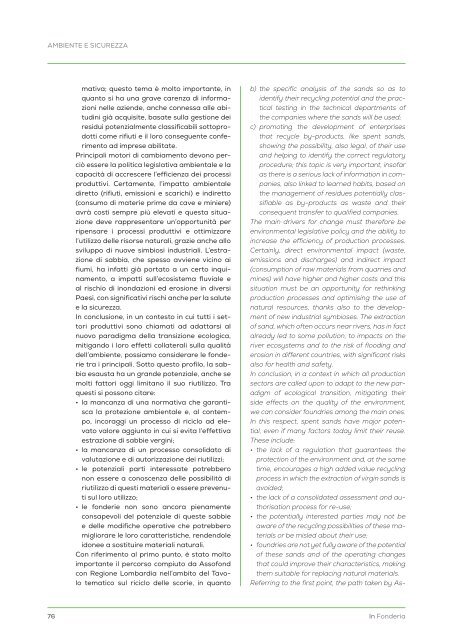In Fonderia 3 2023
Terzo numero del 2023 di In Fonderia
Terzo numero del 2023 di In Fonderia
Create successful ePaper yourself
Turn your PDF publications into a flip-book with our unique Google optimized e-Paper software.
AMBIENTE E SICUREZZA<br />
mativa; questo tema è molto importante, in<br />
quanto si ha una grave carenza di informazioni<br />
nelle aziende, anche connessa alle abitudini<br />
già acquisite, basate sulla gestione dei<br />
residui potenzialmente classificabili sottoprodotti<br />
come rifiuti e il loro conseguente conferimento<br />
ad imprese abilitate.<br />
Principali motori di cambiamento devono perciò<br />
essere la politica legislativa ambientale e la<br />
capacità di accrescere l’efficienza dei processi<br />
produttivi. Certamente, l’impatto ambientale<br />
diretto (rifiuti, emissioni e scarichi) e indiretto<br />
(consumo di materie prime da cave e miniere)<br />
avrà costi sempre più elevati e questa situazione<br />
deve rappresentare un’opportunità per<br />
ripensare i processi produttivi e ottimizzare<br />
l’utilizzo delle risorse naturali, grazie anche allo<br />
sviluppo di nuove simbiosi industriali. L’estrazione<br />
di sabbia, che spesso avviene vicino ai<br />
fiumi, ha infatti già portato a un certo inquinamento,<br />
a impatti sull’ecosistema fluviale e<br />
al rischio di inondazioni ed erosione in diversi<br />
Paesi, con significativi rischi anche per la salute<br />
e la sicurezza.<br />
<strong>In</strong> conclusione, in un contesto in cui tutti i settori<br />
produttivi sono chiamati ad adattarsi al<br />
nuovo paradigma della transizione ecologica,<br />
mitigando i loro effetti collaterali sulla qualità<br />
dell’ambiente, possiamo considerare le fonderie<br />
tra i principali. Sotto questo profilo, la sabbia<br />
esausta ha un grande potenziale, anche se<br />
molti fattori oggi limitano il suo riutilizzo. Tra<br />
questi si possono citare:<br />
• la mancanza di una normativa che garantisca<br />
la protezione ambientale e, al contempo,<br />
incoraggi un processo di riciclo ad elevato<br />
valore aggiunto in cui si evita l’effettiva<br />
estrazione di sabbie vergini;<br />
• la mancanza di un processo consolidato di<br />
valutazione e di autorizzazione dei riutilizzi;<br />
• le potenziali parti interessate potrebbero<br />
non essere a conoscenza delle possibilità di<br />
riutilizzo di questi materiali o essere prevenuti<br />
sul loro utilizzo;<br />
• le fonderie non sono ancora pienamente<br />
consapevoli del potenziale di queste sabbie<br />
e delle modifiche operative che potrebbero<br />
migliorare le loro caratteristiche, rendendole<br />
idonee a sostituire materiali naturali.<br />
Con riferimento al primo punto, è stato molto<br />
importante il percorso compiuto da Assofond<br />
con Regione Lombardia nell’ambito del Tavolo<br />
tematico sul riciclo delle scorie, in quanto<br />
b) the specific analysis of the sands so as to<br />
identify their recycling potential and the practical<br />
testing in the technical departments of<br />
the companies where the sands will be used;<br />
c) promoting the development of enterprises<br />
that recycle by-products, like spent sands,<br />
showing the possibility, also legal, of their use<br />
and helping to identify the correct regulatory<br />
procedure; this topic is very important, insofar<br />
as there is a serious lack of information in companies,<br />
also linked to learned habits, based on<br />
the management of residues potentially classifiable<br />
as by-products as waste and their<br />
consequent transfer to qualified companies.<br />
The main drivers for change must therefore be<br />
environmental legislative policy and the ability to<br />
increase the efficiency of production processes.<br />
Certainly, direct environmental impact (waste,<br />
emissions and discharges) and indirect impact<br />
(consumption of raw materials from quarries and<br />
mines) will have higher and higher costs and this<br />
situation must be an opportunity for rethinking<br />
production processes and optimising the use of<br />
natural resources, thanks also to the development<br />
of new industrial symbioses. The extraction<br />
of sand, which often occurs near rivers, has in fact<br />
already led to some pollution, to impacts on the<br />
river ecosystems and to the risk of flooding and<br />
erosion in different countries, with significant risks<br />
also for health and safety.<br />
<strong>In</strong> conclusion, in a context in which all production<br />
sectors are called upon to adapt to the new paradigm<br />
of ecological transition, mitigating their<br />
side effects on the quality of the environment,<br />
we can consider foundries among the main ones.<br />
<strong>In</strong> this respect, spent sands have major potential,<br />
even if many factors today limit their reuse.<br />
These include:<br />
• the lack of a regulation that guarantees the<br />
protection of the environment and, at the same<br />
time, encourages a high added value recycling<br />
process in which the extraction of virgin sands is<br />
avoided;<br />
• the lack of a consolidated assessment and authorisation<br />
process for re-use;<br />
• the potentially interested parties may not be<br />
aware of the recycling possibilities of these materials<br />
or be misled about their use;<br />
• foundries are not yet fully aware of the potential<br />
of these sands and of the operating changes<br />
that could improve their characteristics, making<br />
them suitable for replacing natural materials.<br />
Referring to the first point, the path taken by As-<br />
76<br />
<strong>In</strong> <strong>Fonderia</strong>














